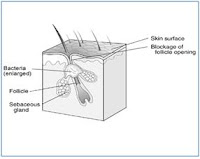Human skin, especially on the face, neck, back, and chest is
covered in hundreds of thousands of microscopic hair follicles, often called
pores.For
reasons no one completely understands, these follicles sometimes overproduce
cells and become blocked. Sebum (oil) which normally drains to the surface gets
trapped and a bacterium begins to grow. All acne lesions start out as a
microcomedone.
 |
| Normal dollicle |

microcomedone
There are two main types of acne
1. Non- inflammatory acne -- Microcomedones
can spontaneously become unplugged and heal or they become non-inflamed skin
blemishes called comedones--either a whitehead or a blackhead.
Whitehead- When
the trapped sebum and bacteria stay
below the skin surface, whitehead is
formed. Whiteheads may show up as tiny white spots, or they may be so small
that they are invisible to the naked eye.
Blackhead - A blackhead
occurs when the pore opens to the surface, and the sebum, which the skin pigment melanin, oxidizes
and turns a brown/black color. It is not dirt and cannot be
washed away. Blackheads can last for a long time because the contents very
slowly drain to the surface.
2. Inflammatory acne - A blackhead or whitehead can release its contents to the surface and heal. Or, the follicle wall can rupture and inflammatory acne can ensue. This rupture can be caused by random occurrence or by picking or touching the skin. This is why it is important to leave acne prone skin relatively untouched
Papule -
Pastule -
A papule or pustule can completely collapse
or explode, severely inflaming the surrounding skin, and may engulf neighboring
follicles. These lesions are called cysts or nodules:
Cyst - Sometimes
a severe inflammatory reaction can result in very large pus filled lesions
Nodule - When a follicle
breaks along the bottom, total collapse can occur, causing a large, inflamed bump that can be sore to the touch.
Severe Forms of Acne
The following severe forms of acne are rare, but they inflict great
hardship to the people who experience them.
Acne Conglobata -
This is the most severe form of acne vulgaris and is more common in males. It
is characterized by numerous large lesions, which are sometimes interconnected,
along with widespread blackheads. It can cause severe, irrevocable damage to
the skin, and disfiguring scarring. It is found on the
face, chest, back, buttocks, upper arms, and thighs. The age of onset for acne
conglobata is usually between 18 to 30 years, and the condition can stay active
for many years. As with all forms of acne, the cause of acne conglobata is
unknown. Treatment usually includes isotretinoin (Accutane), and although acne
conglobata is sometimes resistant to treatment, it can often be controlled
through aggressive treatment over time.
Acne Fulminans - This is an abrupt
onset of acne conglobata-like symptoms which normally afflicts young Caucasian
men.14-16 Symptoms of severe nodulocystic, often ulcerating acne are apparent.
As with acne conglobata, extreme, disfiguring scarring is common. Acne fulminans is unique in that it also includes a fever and aching of the joints.15 Hospitalization of 3-5 weeks is typical for
treatment.16 Acne fulminans does not respond well to antibiotics. Isotretinoin (Accutane) and oral steroids are
normally prescribed.
Gram-Negative
Folliculitis - This condition is a bacterial infection
characterized by pustules and cysts, possibly occurring as a complication
resulting from a long term antibiotic treatment of acne vulgaris.14 It is a
rare condition, and we do not know if it is more common in males or females at this time. Fortunately,
isotretinoin (Accutane) is often effective in combating gram-negative
folliculitis.
Pyoderma Faciale
(Rosacea Fulminans) - This type of severe
facial acne affects only females, usually between the ages of 20 to 40 years
old, and is characterized by large painful nodules, pustules, and sores, all of
which may scar.14-15,17 It begins abruptly, and may occur on the skin of a
woman who has never had acne before.15-17 It is confined to the face, and usually does not last longer than one
year, but can wreak havoc in a very short time. Doctors often prescribe isotretinoin (Accutane) as well as systemic corticosteroids.
|









No comments:
Post a Comment
Speak Your Mind! Comment Below.